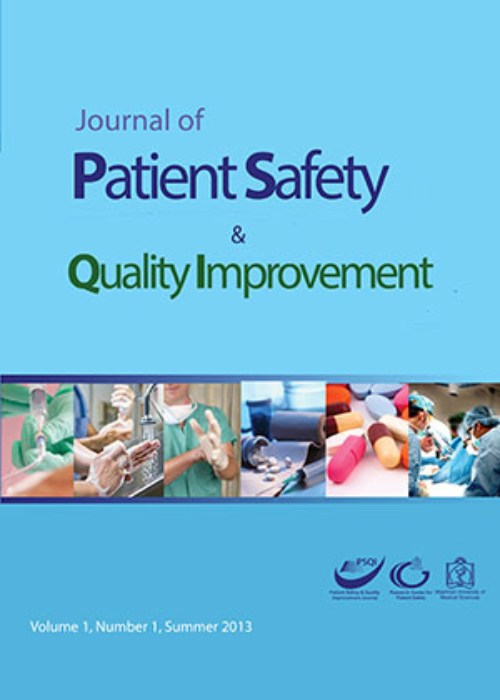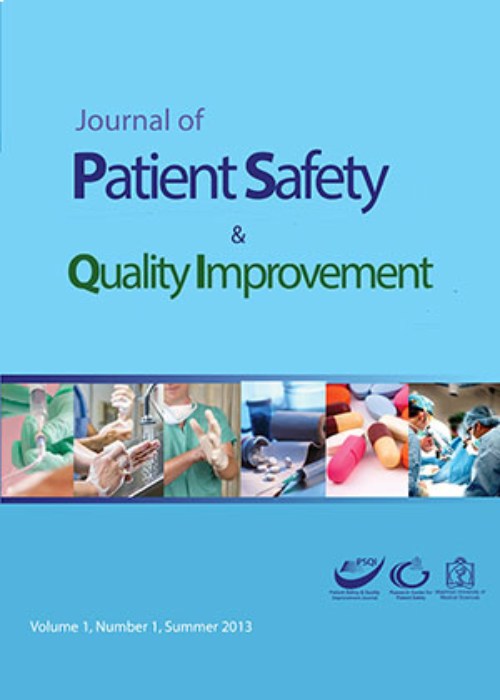فهرست مطالب

Journal Of Patient safety and quality improvement
Volume:11 Issue: 1, Winter 2023
- تاریخ انتشار: 1402/02/31
- تعداد عناوین: 8
-
Pages 3-11IntroductionHandover is an important part of clinical practice and its failure is a major preventable cause of patient harm. With increasingly varied work patterns for all healthcare professionals, ensuring good and effective handover is paramount. Guidance has been created to highlight key handover principles. However, clinical surveys show wide variability between hospitals with limited or no defined handover processes.
Materials and MethodsA single-centre quality improvement project with the implementation of a structured handover algorithm was performed, over five successive Plan-Do-Study-Act (PDSA) cycles. The inclusion of key elements identified in the literature as being important for effective handover were measured. These elements were assessed and monitored after the implementation of the structured handover algorithm and further interventions, including direct algorithm demonstration and change of handover location, as part of sequential PDSA cycles, following medical team (consultants, junior doctors and specialist nurses) consensus.ResultsThe baseline assessment of the hospital’s handover processes showed them to lack key handover elements. Through the introduction of the handover algorithm, the handover process improved significantly. Following the interventions all but two key handover elements were present in 100% of handovers with the two further elements present in at least 75% of handovers. These findings were sustained over five successive PDSA cycles.
ConclusionA structured handover algorithm improves handover practice. The structured framework of the algorithm acts as an aid, avoiding key elements from being missed and imprinting them into routine handover practice. The improvement methodologies and interventions of this study can potentially benefit further clinical settings and be adapted accordingly.Keywords: Handover, PDSA, Quality Improvement, team training -
Pages 13-21Introduction
COVID-19 has placed immense burdens on healthcare systems and medical staff. To avoid spread, the statistician’s role and the use of appropriate predictive models -prediction of survivors versus non-survivors- is highly relevant. This study aimed to apply a model which avoids overfitting and selection bias towards selecting predictors to predict COVID-19 mortality.
Materials and MethodsThe Conditional Inference Tree (CIT) model was used. Data from 59,564 hospitalized individuals with positive polymerase chain reaction (PCR) test results were collected from February 20, 2020, to September 12, 2021, in the Khorasan Razavi province, Iran.
ResultsThe sensitivity and specificity of the model were 88.7% and 88.1%, respectively, the accuracy was 88.2%, and the area under the curve (AUC) was 73.0% on test data. Therefore, the model had considerable accuracy in prediction. The potential predictors involved in predicting survivors versus non-survivors were intubation, age, PO2 level, decreased consciousness level, presence of distress, anorexia, drug use, and kidney diseases.
ConclusionAccording to the findings, the CIT model showed high accuracy by avoiding overfitting and selection bias toward selecting predictors. Thus, the results of this study and the efforts of healthcare systems to stop the spread of this pandemic prove helpful.
Keywords: Conditional Inference Tree, COVID-19, Data mining, Decision Trees, Machine Learning -
Pages 23-31Introduction
The improvement of patient safety and the quality of life in acute coronary syndrome (ACS) patients are the main objectives of health care systems. Self-management education programs are thus considered one of the effective protocols to improve patients’ quality of life. This study aimed to evaluate the effect of the self-management protocol 5A model on elderly ACS patients’ quality of life.
Materials and MethodsThis clinical trial was conducted on 53 ACS patients of the Cardiology Department, Imam Reza Hospital, Bojnourd, Iran. Patients were selected according to the permutation blocks for two groups: intervention and control. The intervention group received a self-management program based on the 5A model: Assessment, Advisement, Agreement, Assistance, and Arrangement. The two groups answered demographic and LIPAD questionnaires during the admission and after two months of follow-up. Data were analyzed by the SPSS software (version 16).
ResultsThe findings presented that most ACS patients were female, married, and uneducated. All dimensions of quality of life increased significantly after the study process (P<0.05). However, these elevated levels were not statistically different between the two groups during the study (P>0.05).
ConclusionWe presented elevated levels of quality of life among ACS cases after the self-management program during the two-month interval. Considering any difference between the two study groups, further research is needed to improve ACS patients’ health levels and quality of life.
Keywords: Acute coronary syndrome, LIPAD questionnaire, Quality of life, Self-management -
Pages 33-39Introduction
In the conditions of disease crisis, workplace indicators play an important role in improving the provision of medical services. This study aimed to evaluate an association between workplace indicators and the health of treatment staff during pandemics in hospitals affiliated with Mashhad University of Medical Sciences.
Materials and MethodsThis cross-sectional study was conducted on healthcare workers with covid-19 infection during the pandemic in hospitals affiliated with Mashhad University of Medical sciences. The data collection tool was the standard “quality of work-life” questionnaire. The validity of this questionnaire was obtained at 0.85. Data were analyzed using analytic statistical tests (chi-square) and descriptive (mean and standard deviation) and using SPSS version 16.
ResultsA total of 442 treatment staff participated in this study, and 230 (52.1%) were women. The mean age was 29.2±9.2 years. The average work history, the average working hours per week, and the average workplace indicators scores were 7.22±10.47, 46.49±12.67, and 109.11±75.46, respectively. The mean quality of work-life score was in the moderate range. There was a statistical association between the mean quality of work-life score with working hours and workplace unit (p<0.001). There was no statistical relation between other variables and to quality of work-life score (p>0.05).
ConclusionThe results indicated that improving workplace indicators is effective in the health of treatment staff and the provision of health services.
Keywords: Coronavirus, Healthcare worker, workplace indicators, hospital personnel, Pandemic -
Pages 41-47IntroductionSurgical site infections (SSIs) are the most common hospital-acquired infections (HAI). They lead to prolonged stay, long-term disability, antimicrobial resistance, the additional financial burden to the healthcare system, the excessive cost for patients and their families and, unnecessary death. Several factors in a patient’s journey during surgery can affect the SSI incidence rate. In this research, we have studied various factors which can influence the SSI rate. This will help in the minimization of the SSI incidence rate.
Materials and MethodsIn this prospective observational analytical study, 104 patients posted for surgery were included. The demographic, clinical and relevant laboratory data were documented. SSI was diagnosed by noting down sign and symptoms like local pain, discomfort, type of discharge from the incision site and daily temperature Chart. Postoperative follow-up was done till 1 month. SPSS v21 was used for analysis of data and Microsoft Excel to generate graphs and tables. Logistic regression analysis, Fisher exact test and Chi-square tests were used for statistical analysis. p-value < 0.05 was considered statistically significant.
ResultsIn this study, 20 patients developed SSI. Socio-economic condition, type of wound, emergency vs. elective, pre-operative and post-operative stay had significant relationship with SSI while gender, age duration of surgery did not have significant effect. Among laboratory findings, urea and total leucocyte count have significant effect while haemoglobin and protein does not have.
ConclusionRisk factors having significant effect on incidence rate of SSI should be addressed before surgical procedure to minimize SSI.Keywords: Risk factors, Surgical site infection, Prevention, World Health Organization -
Pages 49-53Introduction
This study aimed to investigate the factors contributing to prolonging the discharge process in a pediatric teaching hospital.
Materials and MethodsThe present study was a descriptive cross-sectional study carried out on 300 patients discharged from one of the pediatric teaching hospitals in Tehran in 2019. This study was conducted using a mixed method. In the quantitative stage, the statistical form was used, the average discharge time in different hospital wards was measured using the stopwatch method, and the data were analyzed using SPSS V. 25 software and descriptive statistics. A qualitative approach was used, including observations, file reviews, Focus Group Discussion (FGD), and brainstorming with experts from the Quality Improvement Office, ward secretaries, clearance unit experts, pharmacy experts, and ward supervisors, to identify the causes of the prolonged process. Finally, the factors were prioritized and approved using the nominal group method.
ResultsThe average discharge time was 3 hours and 7 minutes; the shortest discharge time belonged to the blood ward, and the longest was to the kidney ward. The causes of delay in discharge were divided into two categories: organizational and human factors.
ConclusionTo improvethe the quality of the discharge process and patient satisfaction, solutions such as having assistants write file summaries before the morning round, sending files out of the ward on time, hiring a circular secretary to collect patients' files from various wards, and controlling them using a standard checklist, nurses' training, and continuous supervision were proposed.
Keywords: Discharge Process, Iran, Pediatric Hospital -
Pages 55-61Introduction
This research aimed to investigate the quality of diagnostic and therapeutic services purchased from specialist doctors using the Servqual model and to provide solutions.
Materials and MethodsThe opinions of 51 specialists were collected regarding the quality of services provided by doctors using the Servqual standard questionnaire. Then, using the Servqual model, the gap between expectations and perceptions was calculated and ranked based on priority from the largest to the smallest gap. In the following, with the help of the Delphi method, with the cooperation of experts, solutions were collected to improve the dimensions, and after that, the importance of the solutions was determined using the second questionnaire.
ResultsGaps in order of priority of reliability, responsiveness, tangibility, assurance, and finally, empathy were determined. Six solutions were determined to improve reliability, 10 to improve responsiveness, 4 to improve physical dimensions (tangible), 9 to improve assurance, and 4 to improve empathy. After ranking the solutions, six solutions that scored lower than the average (3.08) were removed, and 27 solutions were approved.
ConclusionConsidering the calculated gap between expectations and perceptions in all dimensions, the following solutions are suggested to reduce the gap; improving the performance of basic insurance organizations, motivating doctors, estimating the price of services based on quality, developing treatment protocols with the help of specialized associations and contracting with doctors by insurance organizations based on the best time for the visit.
Keywords: Service quality. Servqual model, Tangible, Reliability, Responsiveness -
Pages 63-72Introduction
This research aimed to identify the challenges of the universal health insurance coverage program in population, cost, and service dimensions and to provide appropriate strategies to achieve this goal based on the SWOT model in the General Department of Health Insurance of North Khorasan.
Materials and MethodsIn this research, by using the Delphi method, the opinions of 43 experts about the strengths and weaknesses, opportunities and threats of the universal health insurance coverage program were collected through interviews and the first questionnaire, and with the help of the second questionnaire, the ranking and importance of each factor were determined. Using the SWOT method, appropriate strategies were compiled.
ResultsThe investigations collected ten strengths, eight weaknesses, ten opportunities, and eight threats. The analysis of these factors led to the codification of eight strategies in the ST region, four in the SO region, four in the WO region, and four in the WT region, and the determination of ten main challenges.
ConclusionAccording to the calculations, the organization’s strategy was placed in the ST area, and the challenges were collected by checking weaknesses and threats. North Khorasan Health Insurance General Administration’s strategy was formulated using strengths to eliminate or reduce threats or homogenous diversity strategy and create diversity in services, and finally, solutions were proposed.
Keywords: Insurance, health, Universal insurance coverage, SWOT model, strategy


